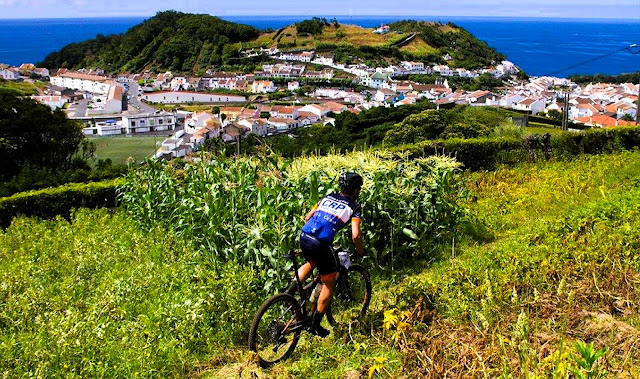LAGOA
(Municipality of São Miguel)
37°44′55″N 25°32′25″W
The municipality of Lagoa is located on the south coast of the island of São Miguel, the largest and most populous of the nine islands of the Azores.
It is one of the six municipalities that make up the island of São Miguel, being limited by the municipalities of Ponta Delgada (to the west), Ribeira Grande (to the north) and Vila Franca do Campo (to the east), with its headquarters located approximately nine kilometers away. from the main city of São Paulo – Ponta Delgada.
Lagoa has a total area of 45.6 km² , spread across its five parishes: Santa Cruz, which includes the town of Remédios, with 14.26 km² ; Nossa Senhora do Rosário, which includes the place of Atalhada, with 5.92 km² ; Cabouco with 5.43 km² ; Ribeira Chã with 2.52 km² and Água de Pau, which includes the place of Caloura, with 17.43 km²
According to the 2011 census, the municipality of Lagoa has 14,442 inhabitants and has a global area of 45.6km².
At a business level, 1121 companies are based in the municipality, representing 2.3% of companies based in the Autonomous Region of the Azores. Commerce and construction companies predominate, with the tertiary sector being pre-eminent in the municipality, taking into account that 50% of the active population, mostly in professions linked to commerce.
With regard to Agriculture, Livestock, Forestry and Fishing, in 2011, there were 197 companies in these sectors that employed around 473 people, which corresponds to an employment of around 17.6% of the active population.
Brief history of the municipality of Lagoa
Soon after the discovery of the island of S. Miguel, Lagoa was one of the first places to be populated, with its first inhabitants settling in the area of the current church of Santa Cruz, next to a lagoon there, which is the reason for the explanatory name given to it. was assigned.
Its geographical location was decisive for its growing protagonism, since Lagoa was located between the two most important towns in São Miguel: Vila Franca do Campo, then the capital of the island, and Ponta Delgada. Mercantile movements and administrative management between these two areas energized the Lagoa, as it was in the Lagoa that merchants and travelers spent the night and supplied themselves with supplies.
Throughout the 15th century, the population of the island of S. Miguel increased significantly and in Lagoa the town developed towards the west, towards a bay that welcomed the first fishing boats: Porto dos Carneiros and towards the east where they settled some families, attracted by promising farmland and an excellent watercourse: Água de Pau. It was thanks to its social and economic progress that Água de Pau would become a town in 1515, becoming the seat of the municipality for 338 years (when it was incorporated into the municipality of Lagoa).
Seven years later, on April 11, 1522, by royal charter from D. João III, Lagoa was elevated to town and the seat of the municipality, being considered one of the best agricultural regions on the island, where wheat crops predominated, of pastries and wine and where there was great economic activity in its port, through the export of products and the sale of fish.
During the 18th century, Lagoa increased its population, developing the construction sector, which intensified with the construction of beautiful houses, manor houses, chapels, and churches.
In the 19th century, the town of Lagoa became one of the main centers for the cultivation and export of oranges to Europe, which made the town of Lagoa prosper, providing a new source of wealth. Soon, new crops were introduced, such as tobacco, beetroot and chicory, which opened the doors to manufacturing activity, simultaneously registering significant economic development.
Economic development was accentuated with the appearance of ceramics and alcohol distillation factories, to which, in the 20th century, new factories were added, namely vegetable oil, soap and animal feed, thus confirming the strong industrial vocation of the Lagoon.
During the 20th century, agricultural exploration and fishing also gained expression and the tertiary sector became the main employer in the municipality, with commercial services predominating. Lagoa begins to emerge for tourist development and service companies begin to grow in number and importance in the municipality's economy.
The municipality is proud of its cultural and tourist offerings.
Whether through visits to museums and viewpoints, walking trails through our parishes, the coastline, or the Serra de Água de Pau, complemented by the enormous quality of our restaurants, Lagoa leaves no one indifferent.
Discover all the offers available by browsing the submenus or contacting a tourist entertainment company based in the municipality.
Also, check out:
💝💝💝💝💝
INDEX
Search in São Miguel Island & Azores
😍😍😍😍 - AZORES ISLANDS
💟💟💟 - São Miguel Island
🔟🔟🔟🔟 - Must-see attractions
💙💙💙💙 - Municipalities
💙💙 - Parishes
Municipalities and Parishes
Sao Miguel Island
AZORES ISLANDS
🙆🙆🙆🙆🙆🙆🙆🙆🙆🙆
🙆🙆🙆🙆🙆🙆🙆🙆🙆🙆
Return to the Index
INDEX
Search in São Miguel Island & Azores
😍😍😍😍 - AZORES ISLANDS
💟💟💟 - São Miguel Island
🔟🔟🔟🔟 - Must-see attractions
💙💙💙💙 - Municipalities
💙💙 - Parishes
Municipalities and Parishes
Sao Miguel Island
AZORES ISLANDS
Return to mainland Portugal and
to the Azores and Madeira islands















No comments:
Post a Comment